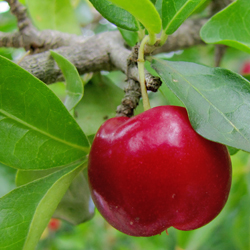Cherry, plums, peaches, apricots and nectarines are in the “stone fruit” group because the seed is quite large. Popular as home fruit trees, there are many varieties available. When choosing a fruit tree for your home, there are several considerations:
- Size: Most fruit trees come in several sizes, standard, semi-dwarf and dwarf. Consider the size of the area available for your tree. Standards become large trees and dropped fruit on a roof is not pleasant.
- Sun: All stone fruit trees require six or more hours of sunlight per day. In any zone, there are many small microclimates created by hills and valleys. A garden at the bottom of a hill will be colder in winter than the garden at the top of the hill. Most stone fruit are native to warm climates and bloom early in the spring. Try to place the tree where the tender buds will receive extra warmth from clear ground or a nearly wall. If your garden is in a colder microclimate, look for a variety setting its buds later in the spring to avoid frost-kill.
- Soil: Because tree roots go deeply into the soil, break up the clay hardpan usually located two feet below the soil surface. If this isn’t possible, consider raising the soil level in the area by constructing a raised bed to provide the extra depth. Dwarf fruit trees do not require as much root depth.
- Pollination: Many varieties of stone fruits are self-fruitful. Others are not. When choosing a variety, check the pollination requirements. If you have room for only one tree, choose one that is self-pollinating. Sometimes trees are available with different varieties grafted onto the tree, thus removing the pollination requirements. These are fun because they provide different tasting fruit from one tree.
How to plant your stone fruit tree
Dig the hole and be sure to break through the hardpan. Or, create a raised bed for the tree. Loosen the soil around the edge of the hole but do not add extra amendments. By adding other products, the roots will tend to grow there and not spread out. This results in a root bound situation.
Build a mound in the bottom of the hole with the top at ground level. Set the tree crown atop the mound and spread the roots out and around the mound. Be sure the crown of the tree is not under the soil. There may be a graft; this should be an inch or two above the ground. After backfilling the hole, create a berm around the hole to contain water while it percolates into the soil.
Watering during the first year is especially important. Water deeply. Shallow watering stunts the roots and will affect tree growth and crop production.
Watch for signs of insects and other pests. If you notice unusual leaves, bring in a sample for problem identification.





